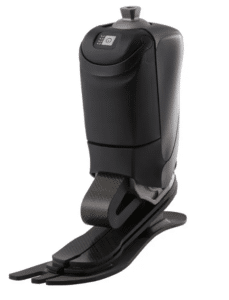
Researchers have found new evidence showing that the benefits of a powered prosthesis can be felt outside the research laboratory. According to the authors, “no study has yet investigated the impact of a powered prosthetic ankle-foot on musculoskeletal pain.” That is, until now.
The research team consisted of researchers from Ottobock Patient Care North America and Ottobock Healthcare LP, the manufacturer of the Empower powered ankle-foot being studied. They studied 57 individuals divided into two groups, 41 of whom were current users of the Empower and 16 of which reported to have used the Empower in the past but had since abandoned it for a passive foot. All participants were male, ages 40-67, with single-sided, below-the-knee amputations resulting mostly from traumatic causes (75.4%). All participants were recruited from the Ottobock Healthcare’s powered ankle patient registry (formerly BionX).
Both groups were asked to complete an online survey to assess socket comfort, function, and pain-level of the knees and lower back. Survey responses were made regarding the use of their current prosthetic foot and recalled experiences with their previous prosthetic foot. Results were then adjusted to account for the potential recall bias – the tendency to recall greater pain and higher function than what was actually experienced.
Results for Socket Comfort
Socket comfort was measured using the Socket Comfort Score (SCS). The group of 41 Empower users reported no significant improvement with use of the Empower compared to a passive foot. Whereas the group of 16 passive foot users reported significantly better socket comfort for the passive foot.
Results for Lower Back and Knee Pain
Pain was measured using the Numeric Pain Rating Scale (NPRS). The group of 41 Empower users reported significantly lower back pain and knee pain on both sides when compared to recalled experience using a passive foot. Further analysis showed that their responses could have been overestimated by as much as 36% due to recall bias. Yet, even after these results were adjusted for recall bias, they still yielded a significantly lower pain rating when using the Empower foot.
In the group of 16 current passive foot users, no significant differences were seen between pain ratings with the passive foot and recalled experience with the Empower foot. Following the adjustment for recall bias, only a significant difference was seen to support the use of the Empower for reduced knee pain on the non-amputated side, whereas none was seen for back pain or amputated side knee pain.
Results for Pain-Related Function
Function was measured using the Activities of Daily Living subset of questions from the Knee Injury and Osteoarthritis Outcome Score (KOOS-ADL) and the Oswestry Disability Index (ODI). In the group of 41 Empower users, the functional scores were significantly better for the Empower foot than the passive foot, even after adjustments were made for recall bias. For the 16 passive foot users, the functional scores were not significantly different for either foot. That is until adjusted for recall bias which resulted favorably for the passive foot.
Conclusions
Use of the Empower may reduce pain, although user preference matters… a lot!
This study shows that for current users of the Empower foot, the relief of lower back and knee pain is measurable. Although the 16 users that prefer a passive foot did not seem to experience these same benefits when using the Empower foot. This proves mostly that the decision to use or not to use the foot was indeed a good choice.
The authors of this study suggest that future research should be done prospectively and should include other factors known to contribute to pain, such as socket fit, prosthetic alignment, pain medication, and physical therapy.
Acknowledgements
We recognize the value of clinical research in identifying the needs, evaluating care, and developing new technologies for people with limb loss and would like to thank the authors Cory E. Cacciola, MS, CPO; Andreas Kannenberg, MD (GER), PhD; Karl D. Hibler, and Jared Howell, MS, CPO, FAAOP for their contributions to advancing O&P research.
Research Citation
- Cacciola CE, Kannenberg A, Hibler KD, Howell J. Impact of a Powered Prosthetic Ankle-Foot Component on Musculoskeletal Pain in Individuals with Transtibial Amputation: A Real-World Cross-Sectional Study with Concurrent and Recalled Pain and Functional Ratings. Journal of Prosthetics and Orthotics 36(1):p 2-9, January 2024. | DOI: 10.1097/JPO.0000000000000442

